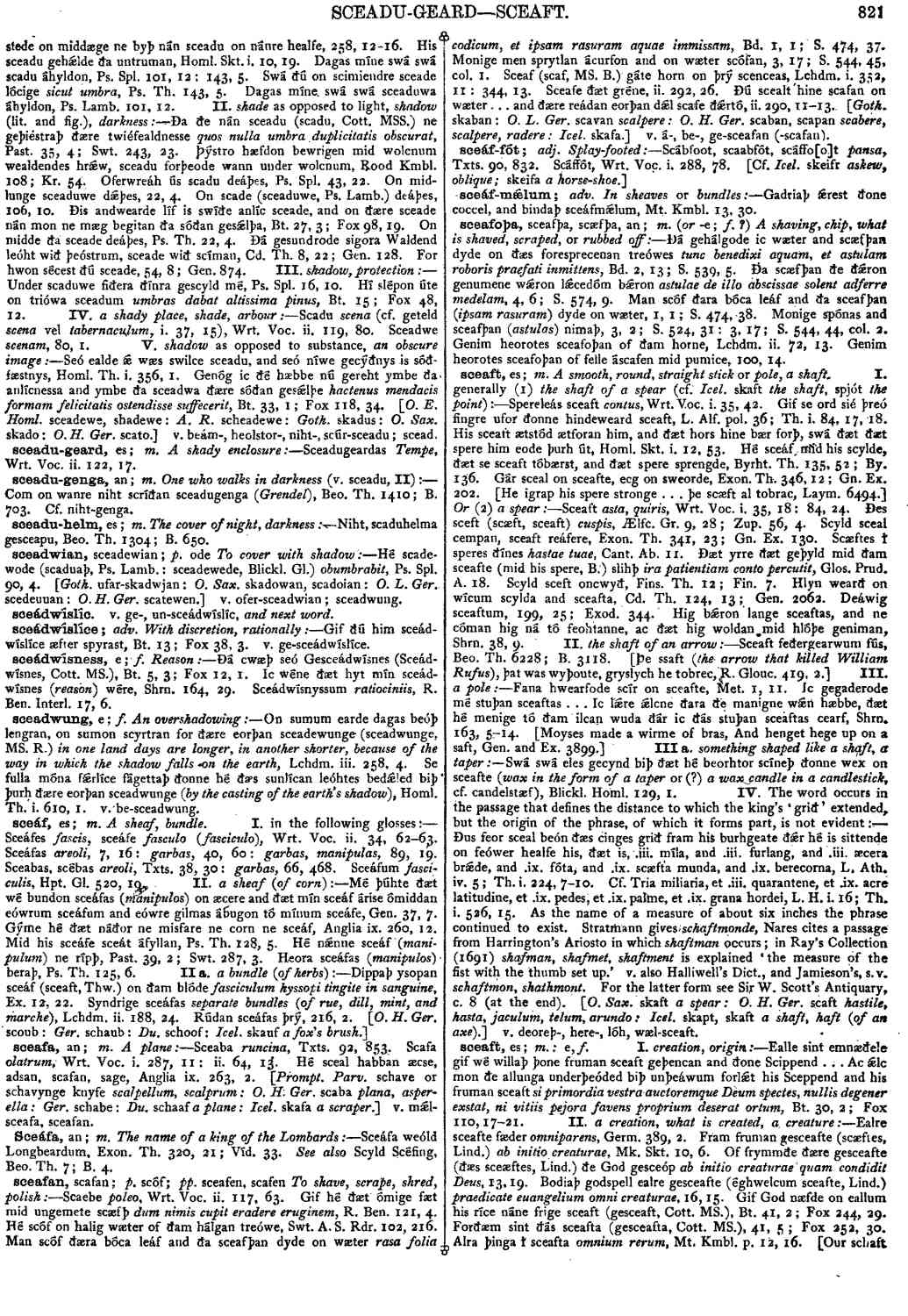sceaft
- noun [ masculine ]
-
Spereleás sceaft
contus,
- Wrt. Voc. i. 35, 42.
-
Gif se ord sié þreó fingre ufor ðonne hindeweard sceaft,
- L. Alf. pol. 36; Th. i. 84, 17, 18.
-
His sceaft ætstód ætforan him, and ðæt hors hine bær forþ, swá ðæt ðæt spere him eode þurh út,
- Homl. Skt. i. 12, 53.
-
Hé sceáf, mid his scylde, ðæt se sceaft tóbærst, and ðæt spere sprengde,
- Byrht. Th. 135, 52; By. 136.
-
Gár sceal on sceafte, ecg on sweorde,
- Exon. Th. 346, 12; Gn. Ex. 202. [He
-
Sceaft
asta, quiris,
- Wrt. Voc. i. 35, 18: 84, 24.
-
Ðes sceft (scæft, sceaft)
cuspis,
- Ælfc. Gr. 9, 28; Zup. 56, 4.
-
Scyld sceal cempan, sceaft reáfere,
- Exon. Th. 341, 23; Gn. Ex. 130.
-
Scæftes ł speres ðínes
hastae tuae,
- Cant. Ab. 11.
-
Ðæt yrre ðæt geþyld mid ðam sceafte (mid his spere, B.) slihþ
ira patientiam conto percutit,
- Glos. Prud. A. 18.
-
Scyld sceft oncwyð,
- Fins. Th. 12; Fin. 7.
-
Hlyn wearð on wícum scylda and sceafta,
- Cd. Th. 124, 13; Gen. 2062.
-
Deáwig sceaftum,
- 199, 25; Exod. 344.
-
Hig bǽron lange sceaftas, and ne cóman hig ná tó feohtanne, ac ðæt hig woldan mid hlóþe geniman,
- Shrn. 38, 9.
-
Sceaft feðergearwum fús, Beo. Th. 6228; B. 3118. [Þe ssaft (
the arrow that killed William Rufus),
þat was wyþoute, gryslych he tobrec,- R. Glouc. 419, 2.
-
Fana hwearfode scír on sceafte,
- Met. 1. 11.
-
Ic gegaderode mé stuþan sceaftas . . . Ic lǽre ǽlcne ðara ðe manigne wǽn hæbbe, ðæt hé menige tó ðam ilcan wuda ðár ic ðás stuþan sceaftas cearf,
- Shrn. 163, 5-14. [Moyses made a
a wax candle in a candlestick,
cf. candelstæf),- Blickl. Homl. 129, 1.
-
Ðus feor sceal beón ðæs cinges grið fram his burhgeate ðǽr hé is sittende on feówer healfe his, ðæt is, .iii. míla, and .iii. furlang, and .iii. æcera brǽde, and .ix. fóta, and .ix. scæfta munda, and .ix. berecorna,
- L. Ath. iv. 5; Th. i. 224, 7-10.
-
Cf. Tria miliaria, et .iii. quarantene, et .ix. acre latitudine, et .ix. pedes, et .ix. palme, et .ix. grana hordei,
- L. H. i. 16; Th. i. 526, 15.
-
As the name of a measure of about six inches the phrase continued to exist. Stratmann gives schaftmonde, Nares cites a passage from Harrington's Ariosto in which shaftman occurs; in Ray's Collection (1691) shafman, shafmet, shaftment is explained 'the measure of the fist with the thumb set up.' v. also Halliwell's Dict., and Jamieson's, s.v.
schaftmon, shathmont.
For the latter form see Sir W. Scott's Antiquary, c. 8 (at the end).
Bosworth, Joseph. “sceaft.” In An Anglo-Saxon Dictionary Online, edited by Thomas Northcote Toller, Christ Sean, and Ondřej Tichy. Prague: Faculty of Arts, Charles University, 2014. https://bosworthtoller.com/26525.
Checked: 0